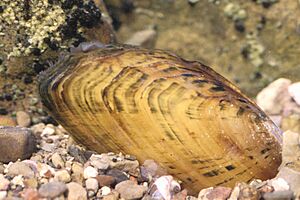Cracking pearlymussel facts for kids
Quick facts for kids Cracking pearlymussel |
|
|---|---|
 |
|
| Conservation status | |
| Scientific classification | |
| Genus: |
Hemistena
|
| Species: |
lata
|
| Synonyms | |
|
|
The cracking pearlymussel (Hemistena lata) is a type of freshwater mussel that is in danger of disappearing. It is an aquatic bivalve mollusk. A bivalve is an animal with two shells, like a clam.
This mussel lives in the United States. Today, you can only find it in Tennessee and Virginia. It used to live in many more places, like the Ohio River, Cumberland River, and Tennessee River systems. But now, it has disappeared from most of those areas.
Scientists have found some populations still living in the Clinch River in Tennessee. Other groups of these mussels are known to survive in the Powell River and Elk River.
What Does a Cracking Pearlymussel Look Like?
These mussels have thin, long shells that are not very strong. Their shells can grow up to about 69 millimeters (or 2.7 inches) long.
The outside of the shell can be yellow or brown. Inside, the shell is a light bluish-white color. There is also a small purple area near the hinge of the shell.
Life Cycle of the Cracking Pearlymussel
Adult cracking pearlymussels spend their lives buried in the sand or mud. They live at the bottom of medium-sized rivers with flowing water.
When it's time to reproduce, female mussels catch sperm that males release into the water. The females store the sperm until they are ready to fertilize their eggs. After the eggs are fertilized, the females release tiny larvae (baby mussels) into the river.
These larvae then attach themselves to fish. They stay on the fish until they grow into young mussels with their own shells. Once they are big enough, they let go of the fish and drop down into the riverbed. There, they bury themselves in the sand or mud. This means that for the mussels to survive, there must be enough fish in the river to act as hosts for their young.
Cracking pearlymussels prefer water that is not too deep, usually less than 2 feet. They also like areas where the water flows at a moderate speed.
Protecting the Cracking Pearlymussel
The cracking pearlymussel faces many dangers that threaten its survival. One major threat is changes to its habitat. This happens when rivers are blocked by dams.
Another problem is silting of rivers. This means too much dirt and mud get into the water. Silting happens because of erosion from construction, farming, and logging. Also, pollution from farms and factories can poison the mussels.
The U.S. Fish and Wildlife Service has created a plan to help this species recover. However, even with these efforts, the cracking pearlymussel is still critically endangered. It has not yet met the goals set for its recovery.



